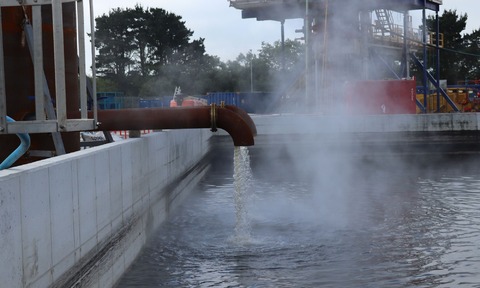
While we cast around for alternatives to fossil fuels that satisfy ethical principles and industrial need, are we in danger of ignoring a solution right under our feet? Emphatically yes, argues Professor Brian J Ford.
Spreading orange powder on that snooker table in Sheffield and the rugby pitch at Twickenham was a great way to capture headlines. Yet the press has pointed out that anti-oil protestors have been seen driving polluting cars. Indeed the orange colour of the powder might well have derived from oil… but it publicised their protest.
Solving the problem is a task, not for campaigners, but for engineers. Fashions change. My engineer grandfather worked on steam locomotives, my father on pneumatic machines. My young days saw the emphasis switch to nuclear power, though those skills have been lost. Now? The emphasis is on alternatives to oil – though my favourite answer has yet to hit the headlines.
Wind generators involve energy-intensive production and installation, and last no more than 25 years, when disposal becomes an issue. Worse, they don’t work during the still, cold nights of winter when we need most energy. Photovoltaics are founded on the labour of enslaved Uyghur people in China, and recycling will soon become a problem. We need electrical energy to light our nights, of course, when photovoltaic cells are dormant.
Many insist that atomic power is the long-term answer. Uranium mostly comes from Kazakhstan, which produces about half the world’s supply. But already they have capped exports, and their reserves have only decades to run.
Sources of uranium can be found in seawater, for instance, though nobody has worked out how to harness them, and fastbreeder reactors could produce fuel for the future, though they remain unpopular. Even then, there is the disposal of nuclear waste. This is a problem cheerfully dismissed by the nuclear industry, but it offers a serious challenge.
Beneath our feet lies all the red-hot energy source we could ever need. Yet few consider it seriously
There are hydroelectric power stations in many rainy nations, and we use water at Dinorwig, Wales, to store electricity. It pumps water uphill using surplus electrical energy, then allows it to power turbines when power is needed. Dinorwig is a battery.
Britain also has tidal power, used for centuries by millers (and mentioned in the Domesday Book of 1086). Only three tide mills survive in working order. I visited the French tidal power station at La Rance, in Brittany. They’ve not tried that again. Years ago I advocated tidal power on the Severn Estuary, and that generated enthusiasm, though not much support.
Yet there is one form of energy that is super-abundant, ubiquitously available, completely inexhaustible, and inherently non-polluting – geothermal power. We live perched on the crust of a globe of molten metal and magma no thicker, size for size, than the layer of paint on a croquet ball. Beneath our feet lies all the red-hot energy source we could ever need. Yet few consider it seriously.
Look up graphs for energy futures, and they list the options: solar, nuclear, wind, hydro, petrochemicals, coal, biomass… there’s nothing on geothermal power. The only ground-based energy taken seriously is used to warm homes through heat pumps. The heat source they use is solar energy, which heats the ground and powers the rainfall that imports warmth. And it’s not as reliable as people say; a home needs near-perfect insulation to become warm in winter.
Yet geothermal power is everywhere. Abandoned coal mines are hot, and by 3,000 metres below Britain the mantle is already at 100°C. Oil wells are often that deep, so the idea is practicable. The deepest ever drilled was in Russia, the Kola Superdeep Borehole SG-3, finished in 1992. It penetrates over 12,000 metres, deeper than the operational height of an airliner, more than the height of Everest and Mount Fuji on top of each other.
Much of central Southampton is now heated by geothermal power, and the Eden Project has just announced that it will use this energy to heat its greenhouses
The temperature at that depth was nearly 200°C. Although it’s now sealed shut with a corroding iron plate and a dozen rusting nuts and bolts, it remains an example we can follow.
Many nations, from Iceland and Italy to St Lucia and Japan, have magma near the surface. The United States leads the world in harnessing geothermal power, though Britain’s many hot-water resources were just regarded as spas. Much of central Southampton is now heated by geothermal power, and the Eden Project has just announced that it will use this energy to heat its greenhouses. The United Downs Deep Geothermal Power project in Cornwall has been claimed to have the potential to power up the whole of Britain.
Yet geothermal energy is not on those graphs of energy futures. I think it should be.
- Pictured above: Professor Brian J Ford (left) with Sir Ghillean Prance, scientific director of the Eden Project in Cornwall

